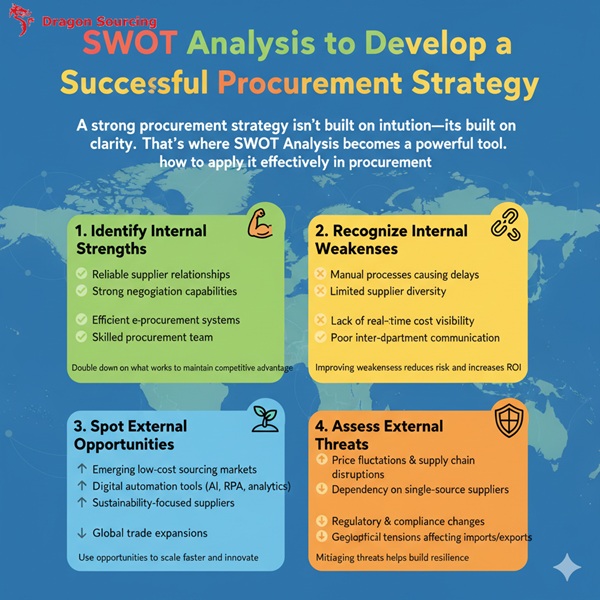
Introduction
In today’s changing global business era, procurement decision makers can no longer rely on intuition to make sourcing decisions. In these complex supplier ecosystems, there is a need for a dynamic strategy for geopolitical disruptions, rising costs, and rapidly evolving digital tools with a data-backed approach.
In this context, one of the most effective frameworks to develop such a strategy is the SWOT Analysis, a well-structured method to find internal and external factors that influence procurement outcomes.
This article explains how organizations can apply SWOT to increase the strength of procurement planning, enhance cost efficiency, and build resilient supply chains.
What is SWOT Analysis in Procurement?
SWOT stands for:
- Strengths → What is your procurement strength functioning well?
- Weaknesses → Internal gaps limiting performance
- Opportunities → External factors enabling growth and innovation
- Threats → External risks that may impact supply stability and costs
SWOT helps procurement decision-makers take decisions based on capability, market conditions, risk variables, and strategic goals when it is applied correctly.
Strengths: Build on What Works
Procurement powers are internal strengths that provide a competitive advantage. These are the factors by your company, which must be leveraged to maximize outcomes.
Common Procurement Strengths:
- Strong, long-term supplier relationships
- Skilled negotiation teams
- Robust e-procurement systems
- Experience in sourcing from global markets
- Centralized vendor evaluation and compliance tools
Why It Matters:
Utilizing capabilities enhances the continuity, better pricing, smoother supplier collaboration, and improved stakeholder satisfaction.
Weaknesses: Identify Areas to Improve
Weaknesses are the limitations that work internally that interrupt procurement performance, efficiency, or scalability.
Typical Weaknesses:
- Manual procurement workflows and Excel-based tracking
- Limited or non-diverse supplier base
- Lack of real-time spend visibility
- Inconsistent quality audits
- Poor consistency with finance or operations
Why It Matters:
Solving the weaknesses lowers cost leakage, avoids delays, and prepares teams for digital transformation.
Opportunities: Leverage Market Trends
Opportunities come from external business factors that firms can work on to expand capabilities and reduce operational costs.
Key Opportunities in Modern Procurement:
- Emerging low-cost sourcing global markets (South Asia, Africa, Latin America)
- Adoption of AI, automation, and analytics tools with software or apps
- Growing availability of ESG-certified and sustainable suppliers
- Global business expansion due to free trade agreements
- Outsourcing and managed procurement activities
Why It Matters:
Taking advantage of these opportunities drives innovation, competitive pricing, and global supply reach.
Threats: Mitigate Risks Early
The last point is threats, which are external forces that may disrupt procurement operations, pricing, or supply stability.
Major Threats Buyers Face Today:
- Geopolitical tensions affecting other countries’ sourcing
- Unexpected price fluctuations in raw materials
- Regulatory changes and compliance burdens
- More dependency on single-source suppliers
- Logistics disruptions, port delays, and freight cost spikes
Why It Matters:
Early external threats help the business houses build contingency plans, diversify vendors, and prevent costly disruptions.
Example: SWOT Snapshot for Procurement Strategy
| Category | Focus Area | Action Steps |
|---|---|---|
| Strength | Strong network of Asian suppliers | Expand sourcing volumes + negotiate better payment terms |
| Weakness | Manual procurement approvals | Implement e-procurement automation |
| Opportunity | AI-based spend analytics | Deploy forecasting tools for cost savings |
| Threat | Dependency on one region | Diversify suppliers across Africa & LATAM |
Final Takeaway
An effective procurement strategy isn’t just about reducing the costs; it’s about building a resilient, scalable, and innovation-ready supply chain.
SWOT analysis provides the roadmap to:
- Strengthen internal capabilities
- Improve operational efficiency
- Capitalize on global sourcing opportunities
- Prepare for risks before they escalate
Procurement teams that successfully analyze strategy will lead the future of sourcing—not follow it.
Author’s Bio:
Pankaj Tuteja
Head of Operations – India
https://www.dragonsourcing.com




